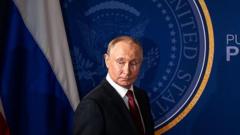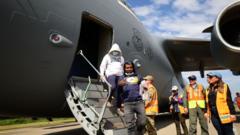The emergence and rapid advancement of hypersonic missile technology by countries like China and Russia signal a significant shift in military capabilities. With speeds exceeding five times that of sound, these weapons threaten to alter traditional warfare and raise alarms about the potential for conflict escalation.
### Global Arms Race: Hypersonic Weapon Developments Shift Military Dynamics

### Global Arms Race: Hypersonic Weapon Developments Shift Military Dynamics
As nations race to develop hypersonic weapons, concerns mount over the balance of power in the current geopolitical landscape.
In a striking display during the 2019 National Day parade, China's unveiling of the DF-17 hypersonic missile set the stage for an intensified arms race involving key global players, including the U.S., Russia, and several other nations. The strategic implications of hypersonic technology are profound, as the speed and maneuverability of these weapons make them challenging to detect and intercept.
While the U.S. and U.K. are stepping up investments in hypersonic research and defense, experts warn that they are currently lagging behind China and Russia, which have committed substantial resources to these programs over the years. The development of dual-use weapons, capable of delivering either conventional or nuclear payloads, adds complexity to defense strategies and heightens anxieties related to potential military confrontations.
Despite the emergence of new technologies, including missile detection systems that leverage advancements in space-based sensors, the dynamics of arms control and military deterrence remain fraught with uncertainty. As countries strive to maintain a strategic edge, it becomes increasingly crucial to balance technological advancements with effective defense measures.
The evolving landscape of hypersonic weapons reflects broader geopolitical tensions, particularly in regions like the South China Sea, where China’s military expansion poses a direct challenge to U.S. interests. The growing capabilities of hypersonic missiles may transform the operational timelines and frameworks of modern warfare, raising critical questions about national security and international stability.
Addressing the dual challenges of keeping pace with hypersonic advancements and establishing robust defense systems will be essential for nations seeking to navigate this new era of military technology. The stakes are undoubtedly high, as the potential for conflict grows amidst a rapidly changing global arms race.
While the U.S. and U.K. are stepping up investments in hypersonic research and defense, experts warn that they are currently lagging behind China and Russia, which have committed substantial resources to these programs over the years. The development of dual-use weapons, capable of delivering either conventional or nuclear payloads, adds complexity to defense strategies and heightens anxieties related to potential military confrontations.
Despite the emergence of new technologies, including missile detection systems that leverage advancements in space-based sensors, the dynamics of arms control and military deterrence remain fraught with uncertainty. As countries strive to maintain a strategic edge, it becomes increasingly crucial to balance technological advancements with effective defense measures.
The evolving landscape of hypersonic weapons reflects broader geopolitical tensions, particularly in regions like the South China Sea, where China’s military expansion poses a direct challenge to U.S. interests. The growing capabilities of hypersonic missiles may transform the operational timelines and frameworks of modern warfare, raising critical questions about national security and international stability.
Addressing the dual challenges of keeping pace with hypersonic advancements and establishing robust defense systems will be essential for nations seeking to navigate this new era of military technology. The stakes are undoubtedly high, as the potential for conflict grows amidst a rapidly changing global arms race.



















